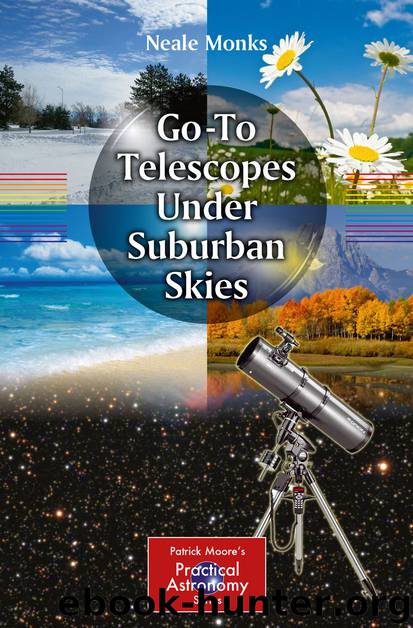Go-To Telescopes Under Suburban Skies by Neale Monks

Author:Neale Monks
Language: eng
Format: epub
Publisher: Springer New York, New York, NY
NGC 6618 (M17, Horseshoe Nebula, Lobster Nebula, Omega Nebula, Swan Nebula)
This interesting object has been known by several names over the years. But to quote the immortal bard, What's in a name? That which we call a rose by any other name would smell as sweet. This is indeed one of the loveliest deep sky objects, a combination of an open star cluster with an emission nebula similar in type to objects like the Lagoon Nebula and the Orion Nebula, but with a charm all its own.
M17 looks good through telescopes of all sizes, appearing as a small L-shaped nebula with a scattering of bright stars set within it. Dark skies are helpful when viewing this object, since without dark skies spotting the nebula will be difficult. Under suburban conditions the use of some type of light pollution filter may be necessary; either a narrowband filter or an O-III might be used, but the flip side to such filters is that the open star cluster will be dimmed and your overall impression of the object somewhat lessened. On the other hand, filters make it easier to see the full extension of the nebula rather than just the brightest bits.
The nebula is a site of active star formation, including the cluster of about 35 bright stars we can see embedded in the nebula. The nebula seems to be bigger and more massive than the Orion Nebula, but being farther away, at least 5,000 light years versus around 1,500 light years for the Orion Nebula, it appears smaller and less brilliant. The bright part of the M17 nebula that we can see is probably about 15 light years in width, but the whole thing is much bigger and more like 40 light years in width.
Like most objects in the Sagittarius-Carina Arm, getting good views of M17 can be tricky for far northern observers. A good clear horizon is important. But it does at least rise reasonably high in the sky; from locations in southern England for example, M17 may reach as much as 22° above the horizon, which should be enough to ensure tolerably good views.
Figure 4.7.M17 includes an open star cluster and an emission nebula. A narrowband or O-III filter will make the nebula easier to see under suburban conditions. (Image produced using Starry Night Pro. AllSky data courtesy of Main-Sequence Software Inc.)
Download
This site does not store any files on its server. We only index and link to content provided by other sites. Please contact the content providers to delete copyright contents if any and email us, we'll remove relevant links or contents immediately.
| Administration & Medicine Economics | Allied Health Professions |
| Basic Sciences | Dentistry |
| History | Medical Informatics |
| Medicine | Nursing |
| Pharmacology | Psychology |
| Research | Veterinary Medicine |
Tuesdays with Morrie by Mitch Albom(4692)
Yoga Anatomy by Kaminoff Leslie(4306)
Science and Development of Muscle Hypertrophy by Brad Schoenfeld(4089)
Bodyweight Strength Training: 12 Weeks to Build Muscle and Burn Fat by Jay Cardiello(3915)
Introduction to Kinesiology by Shirl J. Hoffman(3726)
How Music Works by David Byrne(3187)
Sapiens and Homo Deus by Yuval Noah Harari(2987)
The Plant Paradox by Dr. Steven R. Gundry M.D(2547)
Churchill by Paul Johnson(2506)
Insomniac City by Bill Hayes(2499)
Coroner's Journal by Louis Cataldie(2433)
Hashimoto's Protocol by Izabella Wentz PharmD(2331)
The Chimp Paradox by Peters Dr Steve(2298)
The Universe Inside You by Brian Clegg(2097)
Don't Look Behind You by Lois Duncan(2080)
The Immune System Recovery Plan by Susan Blum(2029)
The Hot Zone by Richard Preston(1983)
Endure by Alex Hutchinson(1964)
Woman: An Intimate Geography by Natalie Angier(1882)
